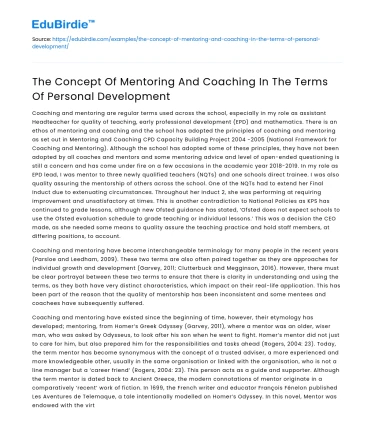Coaching and mentoring are regular terms used across the school, especially in my role as assistant Headteacher for quality of teaching, early professional development (EPD) and mathematics. There is an ethos of mentoring and coaching and the school has adopted the principles of coaching and mentoring as set out in Mentoring and Coaching CPD Capacity Building Project 2004 -2005 (National Framework for Coaching and Mentoring). Although the school has adopted some of these principles, they have not been adopted by all coaches and mentors and some mentoring advice and level of open-ended questioning is still a concern and has come under fire on a few occasions in the academic year 2018-2019. In my role as EPD lead, I was mentor to three newly qualified teachers (NQTs) and one schools direct trainee. I was also quality assuring the mentorship of others across the school. One of the NQTs had to extend her Final Induct due to extenuating circumstances. Throughout her Induct 2, she was performing at requiring improvement and unsatisfactory at times. This is another contradiction to National Policies as KPS has continued to grade lessons, although new Ofsted guidance has stated, ‘Ofsted does not expect schools to use the Ofsted evaluation schedule to grade teaching or individual lessons.’ This was a decision the CEO made, as she needed some means to quality assure the teaching practice and hold staff members, at differing positions, to account.
Coaching and mentoring have become interchangeable terminology for many people in the recent years (Parsloe and Leedham, 2009). These two terms are also often paired together as they are approaches for individual growth and development (Garvey, 2011; Clutterbuck and Megginson, 2016). However, there must be clear portrayal between these two terms to ensure that there is clarity in understanding and using the terms, as they both have very distinct characteristics, which impact on their real-life application. This has been part of the reason that the quality of mentorship has been inconsistent and some mentees and coachees have subsequently suffered.
Save your time!
We can take care of your essay
- Proper editing and formatting
- Free revision, title page, and bibliography
- Flexible prices and money-back guarantee
Coaching and mentoring have existed since the beginning of time, however, their etymology has developed; mentoring, from Homer’s Greek Odyssey (Garvey, 2011), where a mentor was an older, wiser man, who was asked by Odysseus, to look after his son when he went to fight. Homer’s mentor did not just to care for him, but also prepared him for the responsibilities and tasks ahead (Rogers, 2004: 23). Today, the term mentor has become synonymous with the concept of a trusted adviser, a more experienced and more knowledgeable other, usually in the same organisation or linked with the organisation, who is not a line manager but a ‘career friend’ (Rogers, 2004: 23). This person acts as a guide and supporter. Although the term mentor is dated back to Ancient Greece, the modern connotations of mentor originate in a comparatively ‘recent’ work of fiction. In 1699, the French writer and educator François Fénelon published Les Aventures de Telemaque, a tale intentionally modelled on Homer’s Odyssey. In this novel, Mentor was endowed with the virtues that have come to be associated with mentoring today (Roberts 1999). From Fenelon’s very popular book, the word mentor, with its current meaning, eventually found its way into the English language.
Most definitions provided in the scholarly and practitioner literature refer back to the seminal studies on workplace mentoring undertaken by Kathy Kram in the 1980s. According to Kram (1985) ‘Mentoring is an intense long-term relationship between a senior, more experienced individual (the mentor) and a more junior, less experienced individual (the protégé)’. (Kram 1985, cited in Eby & Allen 2002, p. 456). She further developed this in 1988 and supported the idea of performance mentoring and suggested that a mentor is someone who is able to help the ‘protégé’ to ‘navigate effectively in the organisational world’ (Kram, 1988).
This early definition has been subsequently critiqued and expanded, so that today there is a proliferation of definitions and discussions of the mentoring concept to be found in the literature. Disputed themes include Can peers be mentors? Can a younger employee mentor an older employee? Can a direct superior be a mentor? Can mentoring be formalised?
Similarly, Daniel Levinson first presented the modern concept of mentoring in the USA in his (1979) book The Seasons of a Man’s Life. This was a substantial longitudinal study of male development. Levinson used the term ‘mentor’ for someone, often half a generation older, who could help accelerate the development of another in his age-related transitions. He suggested that mentoring could reduce these age transitions from an average of seven to three years. This very quickly became the catalyst for a rapid growth in mentoring that would focus on an accelerated career progression in the USA. Levision’s ideology of mentoring supported the idea that a mentor had to be knowledgeable and experienced in a particular field and had to be older. However, this raises some thought-provoking questions: How experienced must a mentor be? How can you measure a mentor’s knowledge? In the context of this assignment, how knowledgeable and experienced was I to mentor and coach a failing NQT? The above definition contradicts the work of Kay and Hinds (2005) who concluded that ‘a mentor is seen as being an equal’ (Kay and Hinds, 2005). The question that arises here is; how can a mentor be an equal, when they possess more experience and knowledge, and according to Levison (1979) is ‘someone often half a generation older’?






 Stuck on your essay?
Stuck on your essay?

